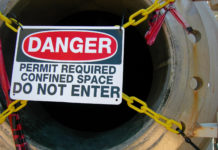(Click state for more info)

UST Map
Alabama | Alaska | Arizona | Arkansas | California | Colorado | Connecticut | Delaware | Florida | Georgia | Hawaii | Idaho | Illinois | Indiana | Iowa | Kansas | Kentucky | Louisiana | Maine | Maryland | Massachusetts | Michigan | Minnesota | Mississippi | Missouri | Montana | Nebraska | Nevada | New Hampshire | New Jersey | New Mexico | New York | North Carolina | North Dakota | Ohio | Oklahoma | Oregon | Pennsylvania | Rhode Island | South Carolina | South Dakota | Tennessee | Texas | Utah | Vermont | Virginia | Washington | Washington DC | West Virginia | Wisconsin
Why is Underground Storage Tank (UST) Operator Training Necessary?
A. It’s The Law
Section 1524 of the Energy Policy Act of 2005 states that the Environmental Protection Agency (EPA), in coordination with states, must develop training guidelines for three distinct classes of operators who operate and maintain federally regulated UST systems.
While the Energy Policy Act was passed in 2005, the guidelines of the act were not effective until Aug. 8, 2007. Under the guidelines, a state had until Aug. 8, 2009 to develop state-specific training requirements consistent with EPA’s guidelines. All three classes of UST operators in every state with completed regulations must be trained according to the state-specific training requirements by Aug. 8, 2012.
- Class A training is required for person(s) having primary responsibility for on-site operation and maintenance of UST systems (owner or operator of a UST facility).
- Class B training is required for persons involved with daily on-site operation and maintenance of UST systems.
- Class C training is required for daily on-site employees having primary responsibility for addressing emergencies presented by a spill or release from a UST system.
In 2015, the Environmental Protection Agency (EPA) revised the underground storage tank (UST) regulations which includes minimum training requirements for owners and operators of UST systems.
B. Environmental Impact
Leaking USTs are a grave threat to America’s groundwater. About 20 million people drink water from small drinking water systems that get rely on groundwater. Gas stations, industries and other entities use USTs to hold toxic material such as gasoline and oil that contain dangerous substances, including benzene, toluene and heavy metals that can cause cancer and harm developing children. Benzene, one of the contaminants released from LUSTs, has been classified by the USEPA and the Department of Health and Human Services (DHHS) as a known human carcinogen that causes acute myelocytic leukemia and bone marrow depression.
Underground Storage Tanks (USTs) can threaten communities as their walls corrode by silently leaking toxins into our drinking water supplies, homes and businesses. Preliminary research has found that children who live near gas stations or automobile repair shops were four times more likely to develop childhood leukemia than children who did not live near such stations establishments. Preventing a spill or release into the environment is the number one priority of an owner/operator of a underground storage tank (UST) system.
[1] Leaking Underground Storage Tanks and Environmental Injustice. US National Library of Medicine National Institutes of Health
[2] Leaking Underground Storage Tanks: A Threat to Public Health & Environment. Sierra Club, April 2005. (PDF)
C. Safety
Proper safety training is essential for the well-being of employees and customers. in order to minimize and prevent accidental leaks and spills to the greatest extent possible, owners and operators must be properly trained and certified in various aspects of system maintenance and operations.
Likewise, employees who perform inspections without proper training run the risk of injury and accidents. Typically it is up to the owner of the UST system to provide adequate training for employees. An employee must also be also be aware of some hazards that may arise from the customer at the pump (smoking, cell phones, static electricity, filling unapproved containers, unattended fueling, etc.).
Proper management of petroleum products, equipping USTs with self-regulating technologies such as leak detectors, implementing mandatory reporting of leaks, and ultimately creating a local environmental hazard surveillance system significantly reduces the prevalence of Leaking Underground Storage Tanks (LUSTs).
D. Financial Impact
The economic value of a business can be negatively impacted by improper operation and monitoring of USTs. A business can be even shutdown if a UST system is found to be out of compliance or in significant violation of UST regulations.
Leaking USTs often lead to costly site assessment and remediation projects. Environmental impacts can prevent you from selling your property or obtaining a loan from the bank. The sooner a release of petroleum is detected and mitigated, the less costly the subsequent spill assessment and remediation will be and the sooner your property will be restored to full value.

















